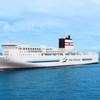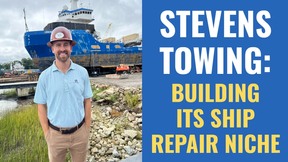New York's New Faces
By Don Sutherland
How many vessels entered New York Harbor for the very first time in the past year or two? Oh, probably a million. And probably most of them kept going, up the North River, out the East River, up to beantown or clamtown in one direction, cheesetown in another. Stop for a snack in New York, it's Boar's Head 24x7. Forty-eight hours later, it's catfish.
Near everything, there are a lot of good reasons to come to New York, and a lot of good reasons to leave. A lot of good reasons to stay too, sometimes. Quite a few new faces have done just that, making New York Harbor all the handsomer. We thought we'd look a few over.
At least four of the boats are new builds, arriving since May 2003; the others are acquisitions to enlarge and upgrade their fleets' capabilities.
Three of the new builds were for small firms, two being family-run and entering the twin-screw business for the first time. The fourth is an AT/B, somewhat the other end of the spectrum. In between is a tractor tug that doesn't look like most tractor tugs, and of course the new big ones, the 124-footers "with the North Sea bows." The old Justine took a new name and went to up the Academy, and a new Justine arrived from the west. Anyone passing-through New York nowadays has plenty of great boats to look at.
NY Newbies
Two of the new tugs, the John P. Brown and the June K., having been built by the same shipyard, at about the same time, to similar specs, were initially thought to be sisters. Both are powered by two Caterpillar 3512Bs giving a total 2700 horsepower. "Twins" was a term that came up, when word got around that they were coming. But their respective owners would not consider them twins. Both Thomas J. Brown & Sons, and Kosanac Floating Derrick Co. specified features to adapt the design of A&B Shipyard to their specific planned futures.
Capt. Fred Kosnac, for example, anticipating business between Staten Island and Albany and maybe beyond, had long journies through river ice in mind. So he ordered extra-thick plates from the bow to the engine room. The June's equipped with a gray water holding tank, making her discharge-free as required - a point they take seriously upstate. The June's upper pilot house folds back when low clearances prevail, and the eye-height ranges from 19 to 28 ft.
Capt. Jim Brown, working extensively in the low-bridge estuaries around the harbor raised the wheelhouse for an eye-height he puts at about 23 ft., but didn't opt for an extension. He increased the height of the wheelhouse windows, and omitted the doors found in the June; felt they would block visibility in the tight corners he frequently works, and make the house colder in winter.
"The yard had never seen what I was describing," he tells us, though if you go back a few decades you'll find plenty of precedent in New York. With the house a tad taller, its lines unbroken by steps to doorways, the John P. Brown recalls the railroad tugs that once kept the city's imports a-coming. So although towing winches aft on the John P. Brown - not present on the June - do a lot for, say, gravel barges headed up the spindly Gowanus, the tug also makes a deja vu in New York with a railroad float on her hip. Several times a week she shunts freight cars of all sorts between Red Hook, Brooklyn, and the Greenville yards at Jersey City, for the New York Cross Harbor Railroad.
Where Capt. Brown runs the John P. mostly as a day boat, the June K. has worked in Connecticut for weeks at a time, as well as upstate - for which accommodations had been expanded for a crew of eight. The John P. Brown's wheelhouse really has a wheel, as besides using the joystick, Capt. Brown sometimes likes steering that way.
The South Rises
Seen side by side, the two boats show family resemblances, but dismiss much thought of "twins." The most noticeable point in common between the 78-footers is the flattish line of the deck - a trait thought in these parts to connote a "southern boat." Like the John and the June, the Normandy has similar lines, also hailing from Loisana (Thoma-Sea Boat Builders).
But everything's on a larger scale. Normandy's a 100-footer with a permanent upper house, and eye-height from 27 to 42 ft. She draws 13 ft. compared to the 9 ft. of the J. and the J., and is fitted with Kort nozzels ("things get stuck in them in shallow waters," Capt. Brown reported). Like the Browns and the Kosnacs, the Mahoneys have been on New York waters for generations - "since 1932, when my father started," said Capt. Paul Mahoney as he eased the boat up Newark Bay on a barge-assist job for Bouchard. "My daughter's not quite in the same business, but it's related - she operates the Mystique, a dinner boat based on the East River." Capt. Mahoney had been running the Pegasus (the modern one, not Capt. Pamela Hepburn's museum boat currently under restoration, and depicted here last month) which was to be joined, a few years ago, by an all-new build. But then the World Trade Center came down, and with it, the bankers' confidence in the dinner boat business. Finances became tight, and Capt. Mahoney had to cancel the new build. The yard found a buyer, and the happy ending - or rather, happy beginning - of that part of the story was recounted in MN September 23 2002 issue, where our review of the 2002 Boston Tug Muster picked-up the story of the Ludwig E and her new owners, Modern Continental.
The "new" Pegasus was sold to Boston-area interests as well. The economic outlook improved quickly, and Capt. Mahoney contracted for the Normandy - "named to honor the Normandy vets of World War II, including my father" - in April 2002. She arrived on Februry 17, 2003 with a pair of Cummins KTA 50M2s rated at 1700 hp each. Capt. Mahoney puts her price at about $3.8 million, but says Normandy's economical to run. "Those Cummins four-strokes save maybe 30 to 32% on fuel, and they don't suck-up a lot of lube - fuel efficiency is my edge," Capt. Mahoney reports.
"I'm following a 'Jet Blue' model," he continued, "everything is first-class." Indeed, the visitor boarding for the first time might think he'd made a wrong turn, and boarded a luxury boat by mistake. The first impression upon entering the galley from aft is of spaciousness - passageways between rooms that are as broad as some rooms. The engine room is enclosed, and the boat's quite quiet. The main pilot house is fully paneled in mahogany. "We live here," says Capt. Mahoney, of himself and his crew.
A wooden foredeck looks like an added touch of class, though it came about simply enough. "We had some time to kill in Houma," Capt. Mahoney recalls, "and we'd found that the bulwarks were a little high for working the forward deck. We thought of raising it with steel gratings, but we thought they'd rattle too much."
They headed for a nearby Home Depot, bought a truckload of lumber, and between 6 AM and 10 PM the crew had their swank forward area.
The Never-Ending Story
We doubt we've covered every new boat to call New York home in the past couple years. We'll catch-up with the rest. Meanwhile, there are older builds that have moved into town. We could have shown more, and maybe we will before long.
But the task we set for ourselves was to run pictures here taken since May '03. As you can see, they make quite a mixture.











